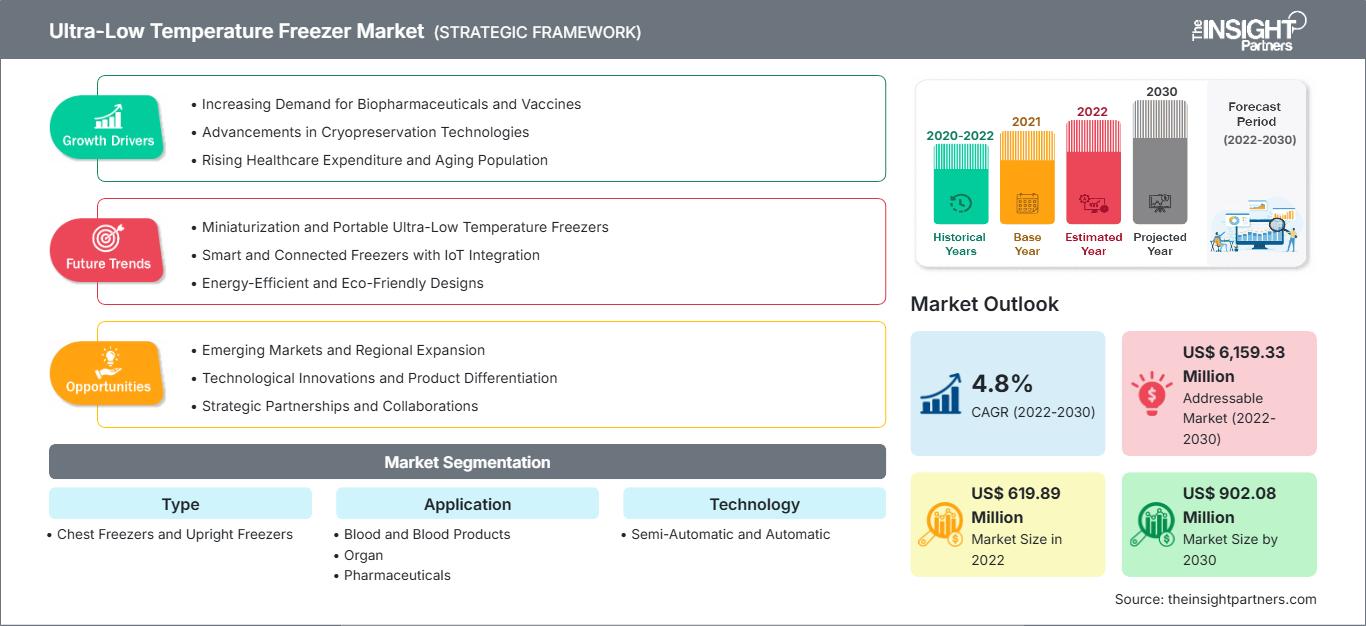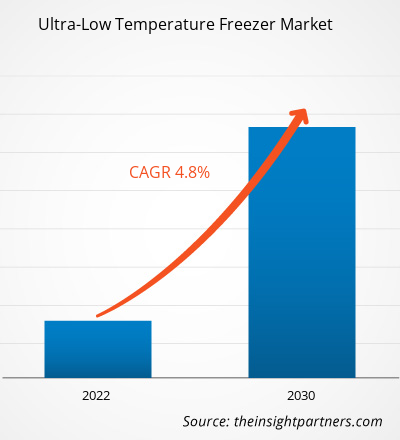[調査レポート] 超低温フリーザー市場は、2022年の6億1,989万米ドルから2030年には9億208万米ドルに成長すると予想されており、2022年から2030年にかけて4.8%のCAGRを記録すると予想されています。
市場分析とアナリストの見解:
超低温フリーザー市場規模は、新薬導入に向けた研究開発活動の増加、血液および血液成分の需要増加、研究活動および臨床試験に対する政府の支援の増加に伴い拡大しています。さらに、市場プレーヤーによる高度な製品の提供が市場の成長を牽引しています。Thermo Scientific Revco RLE -86°C直立型フリーザーは5つの容量で提供され、300〜700個の2インチボックスを保管できます。これらのフリーザーは、優れた熱性能、安全性、セキュリティを提供します。
成長の原動力と課題:
生物学研究標本は、80℃以下の温度、つまり超低温(ULT)値で保管する必要があります。ULT機能は、標準的なコンプレッサーベースの冷却技術に代わるものであり、その理解が深まるにつれてさらに向上しています。Haier Biomedicalが提供する革新的な製品には、スマート周波数変換技術を備えたULTフリーザーがあり、ユニット容量が829 L/29.2 ft3で、わずか8.2 Kwhr/日という比類のないエネルギー消費量を実現します。2022年10月、サーモフィッシャーサイエンティフィックは、超低温(ULT)グリーンポートフォリオに新しいフリーザー、Thermo Scientific TDEシリーズ-80℃チェストフリーザーを発売しました。この冷凍庫はHドライブ炭化水素システムを搭載しており、持続可能性の目標を損なうことなく、重要な研究に必要な性能を向上させます。2023年6月、BioLife Solutionsのスターリング超低温直立型ULT冷凍庫(ISOクラス6)は、バイオストレージの性能や環境の清浄性を損なうことなく、関連する適正製造規範(GMP)に準拠したクリーンルーム用途の承認を取得しました。
ULTサンプル保管用冷凍庫は、世界中の多くのバイオバンク、クリニック、研究所にとって重要な構成要素です。これらのユニットは、DNA、RNA、タンパク質、細胞抽出物など、多種多様な生物学的サンプルの保管を可能にします。低温レベルを維持するには、安定した電源供給が必要です。国際持続可能研究所(International Institute for Sustainable Laboratories)によると、平均的なULT冷凍庫の消費電力は、戸建て住宅の消費電力と同じで、1日あたり20kWhです。研究所や研究施設では通常、数十台のULT冷凍庫が同時に稼働していることを考えると、運用コストとエネルギーコストがユーザーの好みを左右する可能性があります。直立型機械式ULTフリーザーの年間平均運転コストは、サイズや温度範囲など、いくつかの要因に応じて750米ドル(570ポンド)から1,000米ドル(750ポンド)の範囲となります。定期的なメンテナンスと霜取りなどのメンテナンスを行うことで、このコストを大幅に削減できます。さらに、上記のULTフリーザーのコストには、HVACシステムと温風除去の追加コストは含まれていません。そのため、ULTフリーザーに関連する高コストは、予算を重視する研究室や保管施設にとって深刻な懸念事項となります。
要件に合わせてレポートをカスタマイズ
レポートの一部、国レベルの分析、Excelデータパックなどを含め、スタートアップ&大学向けに特別オファーや割引もご利用いただけます(無償)
超低温冷凍機市場: 戦略的洞察

-
このレポートの主要な市場動向を入手してください。この無料サンプルには、市場動向から見積もりや予測に至るまでのデータ分析が含まれます。
レポートのセグメンテーションと範囲:
超低温冷凍庫市場は、タイプ、アプリケーション、テクノロジー、および地域に基づいて分割されています。 超低温冷凍庫市場は、アプリケーション別に、血液および血液製剤、臓器、医薬品、法医学およびゲノム研究、およびその他の分野に分類されています。 市場は、テクノロジー別に、自動と半自動に分かれています。
地理に基づいて、超低温冷凍庫市場は、北米(米国、カナダ、メキシコ)、ヨーロッパ(イギリス、ドイツ、フランス、イタリア、スペイン、ロシア、その他のヨーロッパ)、アジア太平洋(中国、日本、インド、韓国、オーストラリア、東南アジア、その他のアジア太平洋)、中東およびアフリカに分割されています。
セグメント分析:
超低温冷凍庫市場は、タイプ別にチェストフリーザーとアップライトフリーザーに分かれています。2022年には、アップライトフリーザーセグメントが大きな市場シェアを占め、同セグメントは2022~2030年にかけて高いCAGRを記録すると予想されています。アップライトフリーザーセグメントの予測される市場成長は、コンパクトなデザイン、整理のしやすさ、さまざまな安全機能の利用可能性などの利点に起因しています。さらに、技術の進歩により操作の監視が向上し、導入率が上がることで、予測期間中の直立型セグメントの超低温冷凍庫市場の成長が促進されるでしょう。
地域分析:
地理に基づいて、超低温冷凍庫市場は、北米、ヨーロッパ、アジア太平洋、中東およびアフリカ、南米および中米に分割されています。北米は、世界の超低温冷凍庫市場の成長に最も大きく貢献しています。アジア太平洋地域は、2022年から2030年にかけて、超低温冷凍庫市場で最高のCAGRを記録すると予想されています。米国における超低温冷凍庫市場の成長は、主に肺がんの有病率の増加、製品の発売、および政府の取り組みによって推進されています。バイオバンクの需要の増加は、米国の医療および経済システムに変革をもたらす可能性をもたらします。しかし、疾患の理解、創薬、開発の必要性から、国内で急速に発展しているバイオバンクへの当面の焦点は高まっています。さらに、バイオバンク研究は、ヒト疾患の遺伝的要素に関する新たな知見を提供し、医療への自動化された、より個別化されたアプローチの開発に焦点を当てています。さらに、米国の複数の市場プレーヤーは、救命につながる発見を加速させることを目的とした、多様で最先端のバイオバンキング製品とサービスのポートフォリオを提供することに注力しています。市場プレーヤー間のビジネス活動の増加は、市場の成長に大きく貢献しています。2020年11月、米国の州や都市の病院は、米国疾病予防管理センター(CDC)の延期勧告を無視し、ファイザー社の新型コロナウイルスワクチン(PFE.N)を安全に保管できる超低温冷凍庫の購入に苦慮していました。
超低温冷凍庫市場
超低温冷凍機市場The Insight Partnersのアナリストは、予測期間を通じて超低温冷凍庫市場に影響を与える地域的な傾向と要因を詳細に解説しています。このセクションでは、北米、ヨーロッパ、アジア太平洋、中東・アフリカ、中南米における超低温冷凍庫市場のセグメントと地域についても解説しています。
超低温冷凍庫市場レポートのスコープ
| レポート属性 | 詳細 |
|---|---|
| の市場規模 2022 | US$ 619.89 Million |
| 市場規模別 2030 | US$ 902.08 Million |
| 世界的なCAGR (2022 - 2030) | 4.8% |
| 過去データ | 2020-2022 |
| 予測期間 | 2022-2030 |
| 対象セグメント |
By タイプ
|
| 対象地域と国 |
北米
|
| 市場リーダーと主要企業の概要 |
|
超低温フリーザー市場のプレーヤー密度:ビジネスダイナミクスへの影響を理解する
超低温フリーザー市場は、消費者の嗜好の変化、技術の進歩、製品メリットへの認知度の高まりといった要因によるエンドユーザーの需要増加に牽引され、急速に成長しています。需要の増加に伴い、企業は製品ラインナップの拡充、消費者ニーズへの対応のための革新、そして新たなトレンドの活用を進めており、これが市場の成長をさらに加速させています。

- 入手 超低温冷凍機市場 主要プレーヤーの概要
業界の発展と将来の機会:
超低温フリーザー市場で活動している主要企業によるさまざまな取り組みを以下に示します。
- 2023年5月、PHC Corporation of North America(PHCNA)は、PHCbiブランドのVIP ECO SMART超低温フリーザーが、国際生物環境貯蔵学会(ISBER)から2023年の権威ある優秀新製品賞を受賞したと発表しました。この製品は、大学、医療機関、製薬会社などのさまざまな施設で使用できるように設計されています。
- 2023年2月、PHC Corporation of North America(PHCNA)は、PHCbiブランドのVIP ECO SMART超低温フリーザーシリーズを発売しました。この新シリーズは、革新的で信頼性の高い超低温フリーザーを基盤として構築されており、セキュリティと使いやすさを向上させながら、省エネ性能を強化しています。
競合状況と主要企業:
超低温フリーザー市場では、Thermo Fisher Scientific Inc、Godrej Group、Haier Group Corporation、Blue Star Limited、Helmer Scientific Inc、PHC Holdings、BioLife Solutions Inc、Eppendorf SE、Meling Biomedical、Arctikoなどが有力企業です。これらの企業は、世界中で高まる消費者需要に対応し、専門ポートフォリオにおける製品ラインナップを拡大するため、新製品の発売と地理的拡大に注力しています。グローバル展開により、幅広い顧客基盤にサービスを提供し、市場拡大を促進しています。
- 過去2年間の分析、基準年、CAGRによる予測(7年間)
- PEST分析とSWOT分析
- 市場規模価値/数量 - 世界、地域、国
- 業界と競争環境
- Excel データセット
最新レポート
関連レポート
お客様の声
購入理由
- 情報に基づいた意思決定
- 市場動向の理解
- 競合分析
- 顧客インサイト
- 市場予測
- リスク軽減
- 戦略計画
- 投資の正当性
- 新興市場の特定
- マーケティング戦略の強化
- 業務効率の向上
- 規制動向への対応






















 無料サンプルを入手 - 超低温冷凍機市場
無料サンプルを入手 - 超低温冷凍機市場